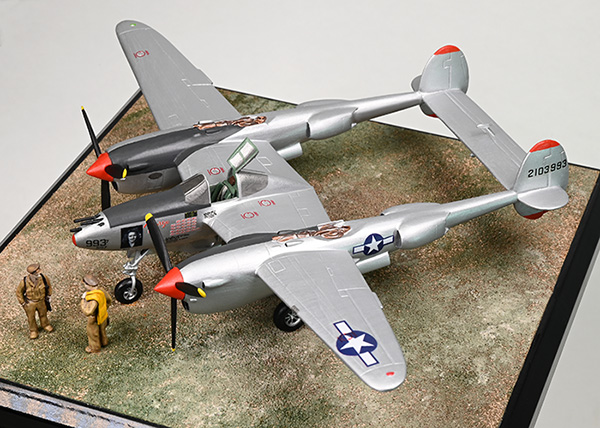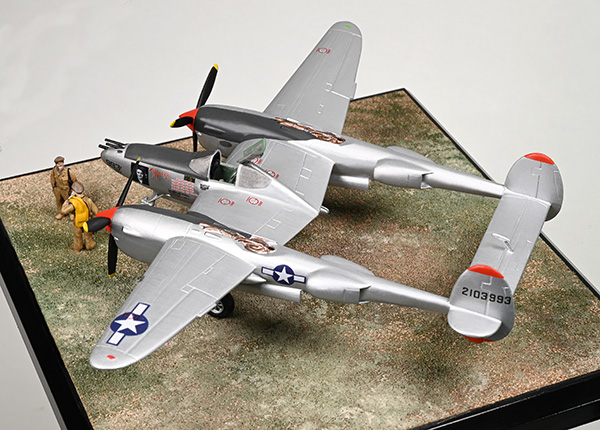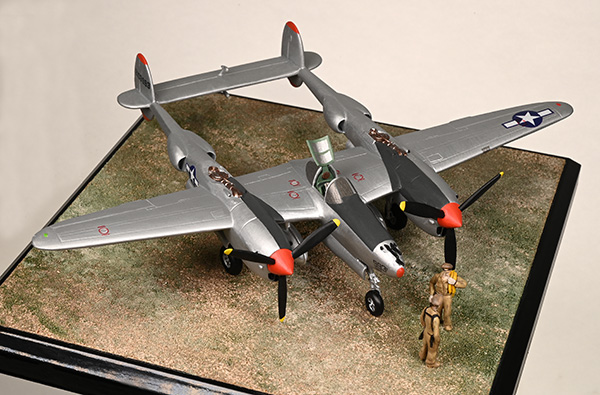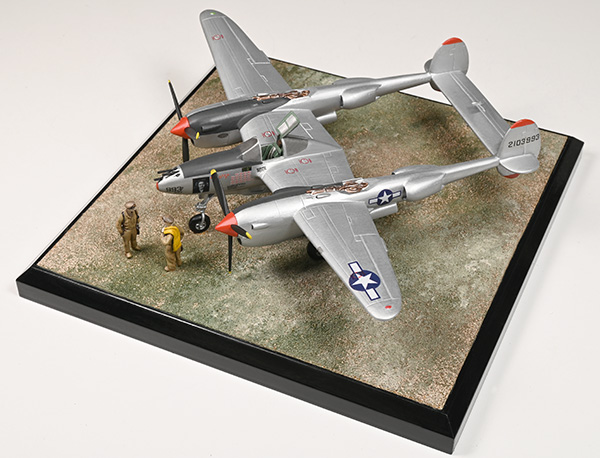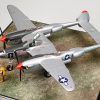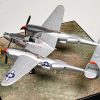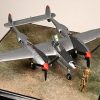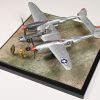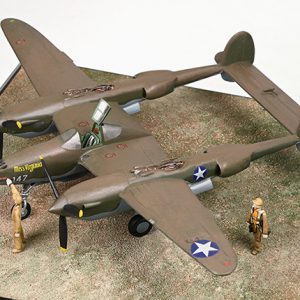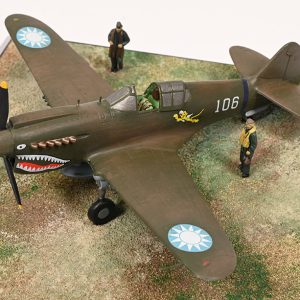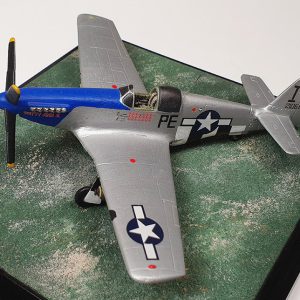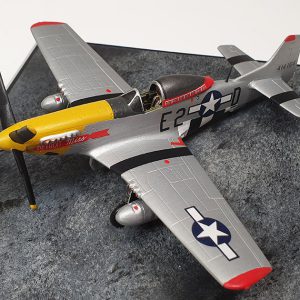Lockheed P-38J-15-LO
‘Marge’ ‘147′ 42-103993
Captain Richard ‘Dick’ Ira Bong, Fifth Fighter Command
Cape Gloucester, March 1944
The Lockheed P-38 was designed as a response to a February 1937 specification from the United States Army Air Corps. This was for a twin-engine, high-altitude “interceptor” having “the tactical mission of interception and attack of hostile aircraft at high altitude.”
The Lockheed design team, under the direction of Hall Hibbard and Clarence “Kelly” Johnson, considered a range of twin-engine configurations, including both engines in a central fuselage with push–pull propellers. Clustering all the armament in the nose was unusual American aircraft, which typically used wing-mounted guns with trajectories set up to crisscross at one or more points in a convergence zone. Nose-mounted guns did not suffer from having their useful ranges limited by pattern convergence, meaning that good pilots could shoot much further.
The Lockheed design incorporated tricycle undercarriage and a bubble canopy, and featured two 1,000 hp (750 kW) turbosupercharged 12-cylinder Allison V-1710 engines fitted with counter-rotating propellers to eliminate the effect of engine torque, this was achieved by the use of “handed” engines, which meant the crankshaft of each engine turned in the opposite direction of its counterpart. Turbochargers were positioned behind the engines, the exhaust side of the units exposed along the dorsal surfaces of the booms.
On the 29th of May 1942, 25 P-38s began operating in the Aleutian Islands in Alaska. The fighter’s long range made it well-suited to the campaign over the almost 1,200 miles (1,900 km)-long island chain, and it was flown there for the rest of the war.
The P-38 was used most extensively and successfully in the Pacific theatre, where it proved more suited, combining exceptional range with the reliability of two engines for long missions over water. The P-38 was used in a variety of roles, especially escorting bombers at altitudes of 18,000–25,000 ft (5,500–7,600 m). It was credited with destroying more Japanese aircraft than any other USAAF fighter
Dick Bong, the United States’ highest-scoring World War II air ace (40 victories in P-38s), flew directly at his targets to ensure he hit them, in some cases flying through the debris of his target. On one occasion colliding with an enemy aircraft, this was claimed as a ‘probable’ victory.
Bong was born in Superior, Wisconsin, on September 24th 1920. He was the first of nine children, son of Carl Bongfrom Sweden, and Dora Bryce, who was an American of Scots-English descent. He grew up on a farm in Poplar, Wisconsin, where he became interested in aircraft at an early age while watching planes fly over the farm carrying mail for President Calvin Coolidge’s summer White House in Superior, and was an avid model builder.
He began studying at Superior State Teachers College in 1938. While there, Bong enrolled in the Civilian Pilot Training Program and also took private flying lessons. On May 29th, 1941, he enlisted in the Army Air Corps Aviation Cadet Program
Bong’s ability as a fighter pilot was recognized while he was training in northern California. He was commissioned a second lieutenant and awarded his pilot wings on January 19th, 1942. His first operational assignment was on May 6th to the 49th Fighter Squadron (FS), 14th Fighter Group at Hamilton Field, California, where he learned to fly the twin-engine Lockheed P-38 Lightning.
On June 12th, 1942, Bong buzzed a house in nearby San Anselmo, the home of a pilot who had just been married. He was cited and temporarily grounded for breaking flying rules, along with three other P-38 pilots who had looped around the Golden Gate Bridge on the same day. For looping the Golden Gate Bridge, flying at a low level down Market Street in San Francisco, and blowing the clothes off of an Oakland woman’s clothesline, Bong was reprimanded by General George C. Kenney, commanding officer of the Fourth Air Force, who told him, “If you didn’t want to fly down Market Street, I wouldn’t have you in my Air Force, but you are not to do it anymore and I mean what I say.” Kenney later wrote, “We needed kids like this lad.” In all subsequent accounts, Bong denied flying under the Golden Gate Bridge. Nevertheless, Bong was still grounded when the rest of his group was sent without him to England in July 1942. Bong then transferred to another Hamilton Field unit, 84th Fighter Squadron of the 78th Fighter Group. From there, Bong was sent to the Southwest Pacific Area.
On September 10th, 1942, Lt. Bong was assigned to the 9th Fighter Squadron, which was flying P-40 Warhawks, based at Darwin, Australia. In November, while the squadron waited for delivery of the scarce P-38s, Bong and other 9th FS pilots were reassigned temporarily to fly missions and gain combat experience with the 39th Fighter Squadron, 35th Fighter Group, based in Port Moresby, New Guinea. On December 27, Bong claimed his initial aerial victory, shooting down a Mitsubishi A6M “Zero”, and a Nakajima Ki-43 “Oscar” over Buna this was during the Battle of Buna-Gona. For this action, Bong was awarded the Silver Star.
Bong rejoined the 9th FS, by then equipped with P-38s, in January 1943. The 49th FG was based at Schwimmer Field near Port Moresby. In April, he was promoted to first lieutenant. On July 26th, Bong claimed four Japanese fighters over Lae, in an action that earned him the Distinguished Service Cross. In August, he was promoted to captain.
While on leave to the United States the following November and December, Bong met Marjorie Vattendahl at a Superior State Teachers’ College homecoming event and began dating her.
After returning to the southwest Pacific in January 1944, he named his P-38J ‘Marge’ and adorned the nose with her photo. On April 12th, Captain Bong shot down his 26th and 27th Japanese aircraft, surpassing Eddie Rickenbacker’s American record of 26 credited victories in World War I. Soon afterwards, he was promoted to major by General George Kenney and dispatched to the United States to see General Arnold, who gave him leave. After visiting training bases and going on a 15-state bond promotion tour, Bong returned to New Guinea in September. He was assigned to the V Fighter Command staff as an advanced gunnery instructor with permission to go on missions but not to seek combat. Bong continued flying from Tacloban, Leyte, during the Philippines campaign; by December 17th, he had increased his air-to-air victory claims to 40.
On the recommendation of General Kenney, the Far East Air Force commander, Bong received the Medal of Honor from General Douglas MacArthur in a special ceremony in December 1944.
In January 1945, Kenney sent America’s ace of aces home for good. Bong married his sweetheart Vattendahl on February 10th, 1945. He then participated in numerous PR activities, such as promoting the sale of war bonds
Bong became a test pilot assigned to Lockheed’s Burbank, California, plant, where he flew P-80 Shooting Star jet fighter at the Lockheed Air Terminal. On August 6th 1945, while testing the P-80, the plane’s primary fuel pump malfunctioned during take-off resulting in the loss of aircraft and pilot. Bong’s death was front-page news across the country, sharing space with the first news of the bombing of Hiroshima.


